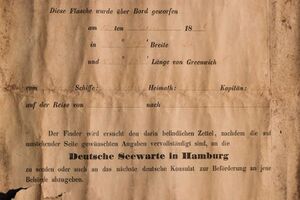Paula (1876 barque)
Topic: Engineering
 From HandWiki - Reading time: 3 min
From HandWiki - Reading time: 3 min
This article or section appears to be slanted towards recent events. (March 2018) (Learn how and when to remove this template message) |
 Paula: Artist Édouard Adam (fr)
| |
| History | |
|---|---|
| Name: | Paula |
| Owner: | A Schiff & Co. |
| Port of registry: | Elsfleth |
| Builder: | Lüring Yard, Hammelwarden |
| Launched: | April 1876 |
| Identification: | |
| Fate: | Last listed 1890 |
| General characteristics | |
| Class and type: | Sailing ship |
| Tons burthen: | 51556⁄94 bom |
| Length: | 38.48 metres (126 ft 3 in) |
| Beam: | 8.31 metres (27 ft 3 in) |
| Draught: | 4.88 metres (16 ft 0 in) |
| Depth: | 4.95 metres (16 ft 3 in) |
| Propulsion: | Sails |
| Sail plan: | Barque |
Paula was a barque built in 1876 in Hammelwarden, Germany.
She participated in a Deutsche Seewarte (de) experiment investigating ocean currents by means of distributing messages in bottles. A bottle dropped by Paula in the Indian Ocean in 1886 was discovered in January 2018 north of Wedge Island, Western Australia.
Description
Paula was 38.48 metres (126 ft 3 in) long with a beam of 8.31 metres (27 ft 3 in). She had a depth of 4.95 metres (16 ft 3 in) and a draught of 4.88 metres (16 ft 0 in).[1] She was assessed at 51556⁄94 tons bom,[2] 533 GRT.[1] She was rigged as a barque.[2]
History
Paula was built in April 1876 at the Lüring Yard, Hammelwarden, Germany for A Schiff & Co.[1] The Code Letters NFKG and German Official Number 4277 were allocated. Her port of registry was Elsfleth.[2] Paula was last listed in the American shipping registers in 1890.[3] She was not listed in 1891.[4]
Message in a bottle find
On 12 June 1886, a message in a bottle was dropped from Paula during a voyage from Cardiff, Wales, United Kingdom to Makassar, Dutch East Indies. The bottle was dropped in the Indian Ocean at [ ⚑ ] 32°49′S 105°25′E / 32.817°S 105.417°E.
On 21 January 2018, the bottle was discovered north of Wedge Island, Western Australia, about 510 nautical miles (940 km) away. The finders contacted the Western Australian Museum who investigated the discovery. They confirmed that the bottle had been dropped as part of an experiment by the German Naval Observatory (Deutsche Seewarte) to determine ocean currents.[5] The bottle and its message were analysed and found to be authentic to the period. The hand-made bottle had originally contained jenever and had come from Schiedam, South Holland, Netherlands.
The previous discovery of a bottle from the programme had been in January 1934 in Denmark.[2] The 131 year time-to-retrieval exceeds the Guinness Book of Records-listed record for the longest such time of 108 years.[6]
References
- ↑ 1.0 1.1 1.2 "Barques - P". The New York Marine Register (New York: American Lloyd's Register). 1876. https://research.mysticseaport.org/item/l0237571877/409/.
- ↑ 2.0 2.1 2.2 2.3 Anderson, Ross; Porr, Christine. "Diese Flasche wurde űber Bord geworfen: a message in a bottle from the German barque Paula (1886) discovered at Wedge Island, Western Australia". Western Australian Museum. http://museum.wa.gov.au/maritime-archaeology-db/sites/default/files/ma_report_325_paula_bottle_message_020318_0.pdf. Retrieved 6 March 2018.
- ↑ "P". Record of American and Foreign Shipping (New York: American Lloyd's Register). 1890. https://research.mysticseaport.org/item/l0179721890/724/.
- ↑ "P". Record of American and Foreign Shipping (New York: American Lloyd's Register). 1891. https://research.mysticseaport.org/item/l0179721891/750/.
- ↑ "132 year old message in a bottle found on WA beach". Western Australian Museum. 6 March 2018. http://museum.wa.gov.au/about/latest-news/132-year-old-message-bottle-found-on-wa-beach. Retrieved 6 March 2018.
- ↑ "Oldest message in a bottle found on Western Australia beach". BBC News. 6 March 2018. https://www.bbc.co.uk/news/world-australia-43299283. Retrieved 6 March 2018.
 |
 KSF
KSF
